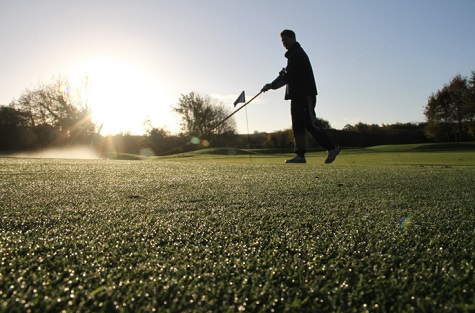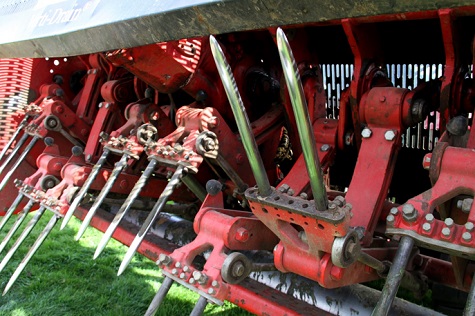We are now entering the autumn and winter periods of the year, when soil and air temperatures are beginning to fall into single figures. The nights are now drawing in and, with the clocks going back at the end of the month, soon we will be in darkness by the late afternoon.
It goes without saying turf professionals are entering a new phase of our working year. Grass growth will start to slow down, and we will be seing more heavy dews on playing surfaces that will exacerbate the incidence of turf disease. This formation of a dew layer creates a warm, moist environment that makes the environmental conditions favourable for certain outbreaks.

Diseases are caused by fungal and bacterial pathogens. If your grass has visible symptoms, the first step is identification to decide if the problem is a plant disease.
Once you have determined that a real problem exists, and is caused by a living organism, you need to decide what type of organism may be causing the damage. Begin by establishing which plant part or growth stage is showing symptoms.
In sports turf situations the problem is generally associated with distorted growth, seedling diseases and leaf symptoms.

Leaf symptoms are seen in many forms: discolouration (yellowing or shades of green), localised or indistinct patterns, usually indicate a virus; dead areas on leaves can be caused by fungi or bacteria. Necrotic areas caused by fungi may contain hyphae or fruiting bodies, particularly after incubation in a warm, moist environment.
Understanding the specific disease, or the life cycle of the pathogen involved, is necessary to ensure effective controls can be implemented. Three major factors contribute to the development of a plant disease: a susceptible host, a virulent pathogen, and a favourable environment. A plant disease results when these three factors occur simultaneously.
Environmental extremes of temperature, light, or moisture can accentuate many diseases. Cool, moist conditions are ideal for many fungal pathogens. Understanding the disease cycle is important when considering control options. Learning the chain of events that contribute to a disease helps point out the weakest links. Control measures can then be used to break the cycle. Most pathogens must survive an adverse period, usually winter, when they do not actively cause plant diseases.

The main management tool for controlling pests and diseases is, by definition, an Integrated Pest Management strategy (IPM) that comprises several tasks and checks providing a comprehensive approach to controlling insects, weeds and pathogens in an economically and environmentally sensitive way, using cultural biological and chemical management tools to reduce the incidence of infection in managed turf. The disease triangle is a concept of plant pathology and is based on the principle that disease is the result of an interaction between a host, a potential pathogen and the environment or weather conditions.
Plant disease is prevented by elimination of any one of these three causal components and of course there are further influences.
Keeping the sward healthy and reducing the conditions that favour disease will be the first priority to keep disease from your turf. The following actions should help you achieve this:
- Carry out programmes of aeration to help keep the surface free draining.
- Inspect and monitor existing surface water drainage systems; ensure that they are working.
- Prevent moist conditions remaining on the surface by brushing/sweeping/switching the playing surface (remove dew).
- Apply a balanced fertiliser to keep the sward healthy. A soil analysis will identify fertiliser requirements.
- Control thatch layers as thatch provides a good environment for the disease outbreaks. Reduce thatch by hollow coring and scarification.
- Reduce the return of clippings. An accumulation of dead matter will increase thatch.
- Maintain Soil pH between 5.8-6.5; do not allow the soil to become alkaline.
- Check mowing heights and keep blades sharp.
- Be vigilant and treat the disease early to prevent severe attacks. Treat with approved fungicides.
- Reduce shade.
Other autumn tasks

The months of October and November are also an optimum time to get some deep aeration work done. This is especially so after the recent downpours we have been having. Soil profiles will have become saturated enabling us to aerate to a depth of around 250mm. Most golf clubs usually spend time getting their fairways, approaches and greens aerated at this time of the year. Also, many sports turf contractors will be offering their services to community football and rugby clubs. For me, it is one of the most important tasks of the year. Having some deep aeration done will be beneficial in keeping these pitches playable during the winter months. The benefits of aeration can be read in a couple of my previous articles here and here.
And finally, autumn sees one of the biggest tasks being undertaken by grounds professionals across all working environments - the job of clearing fallen leaves.

October sees the start of this time consuming task and usually goes on until late November, depending on weather conditions. Usually a good couple of frosts and some stormy days will help trees loose there leaves more quickly.
However, the task of clearing them up is still a time-consuming job. At least long gone are the days when you only had hand rakes to shift them. Back in the day when I was working in Cannon Hill Park, Birmingham, in the late 1970s, we generally had all the staff of the park spending the morning raking up leaves. Today we are lucky to have the plethora of hand-held and tractor mounted leaf blowers and vacuums to help us carry out the job more efficiently.